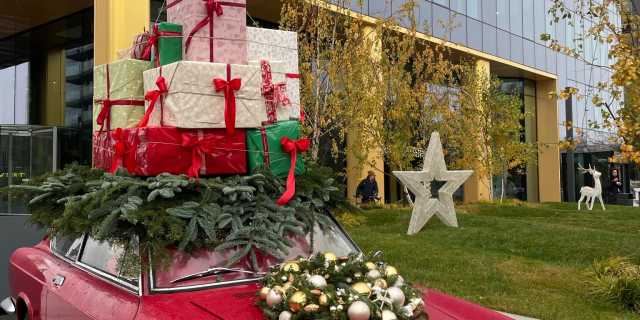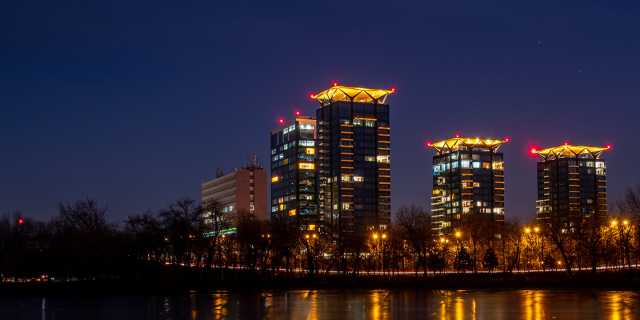Bucharest National Theatre
The first steps in the construction of the National Theatre were made in 1836, when the Philharmonic Society, established two years before, acquired the Câmpinencii Inn for this purpose. Following the approval of the project by the ruler Alexandru Ghica in 1840, five years later, the first building of the theatre was completed in Baroque style, according to the plans of the Viennese architect Heft. However, it would be destroyed in less than a century, following a Nazi bombing in 1944. Only in the winter of 1973, on December 20, the current building of the National Theatre was inaugurated, in a project by the architects Horia Maicu, Romeo Belea, and Nicolae Cucu, together with the engineer Alexandru Cișmigiu, who designed the resistance structure. Designed as a hat, in the modernist style of the '60s, but unfinished on the outside, the new theatre operated in three halls: the Small Hall, the Great Hall, and the Atelier Hall. Following a fire, the theatre was remodelled at the command of dictator Ceaușescu and a new hall was opened – Amphitheatre, the original form of the building being covered. In 2012, the decision was made to start a new renovation of the theatre, on which occasion the Ceaușescu influences are removed, and the old design is restored, under the supervision of Romeo Belea, one of the three original architects. The interior space is also considerably increased, from 1,720 to 2,880 seats, and the number of halls increases to seven. The theatre is named after the prominent Romanian novelist Ion Luca Caragiale.
CEC Palace
Built between 1897-1900, on the site of the former monastery and the "Saint John the Great" inn, demolished in 1875, the CEC Palace bears the signature of the architect Paul Gottereau. However, the plans were implemented by the Romanian architect Ion Socolescu. The building was developed during the reign of King Carol I of Romania and Queen Elisabeta and was originally called the Palace of the House of Deposits, Consignments, and Economy. The emblematic exterior of the building shows elements of eclecticism, an architectural current that combines a multitude of styles, especially French architecture. These include an imposing entrance, composite-style columns, a series of Renaissance-style domes, and a central dome for which glass and metal were used. The statues of the mythological deities Mercury (the god of trade) and Demeter (the goddess of fertility and wealth), placed above the monumental entrance, were made by the Romanian sculptor Athanasie Constantinescu. The interior of the palace is not left behind either, being adorned with paintings by the artist Mihail Simonidi, geometric shapes rendered by using natural stone mosaic, marble stairs, and massive chandeliers, among others. Currently, the monument houses the headquarters of the financial institution CEC Bank.
Stavropoleos Church
Designed in Brâncoveanu style, the Stavropoleos Orthodox Church has a history of over three centuries. Its construction, started in 1724 and completed the same year, during the reign of Nicolae Mavrocordat, is due to the Greek archimandrite Ioanichie Stratonikeas. He built here not only the church, but also an inn and a series of annexes, demolished at the end of the 19th century. As elements of the Brâncoveanu style, stone decorations, ornamental motifs, and interior and exterior mural painting were used. At the beginning of the last century, a new annex was built, using the plans of the architect Ion Mincu, and the interior of the church was restored, under the guidance of the illustrious architect. It was built in neo-Romanian style, to house a library, a restoration workshop, a series of cells, and a collection of icons, objects of worship, and fragments of fresco recovered from various churches demolished during the communist period.
The Fire Tower
Built in 1890, according to the plans of George Mandrea, former chief architect of Bucharest, the Fire Tower has a height of 42 meters and served as an observation tower for fires in the Capital. Initially, the building was designed to be used as a water tower, but after completion, it was found that the plant that was to supply it did not have pumps strong enough to fill it. As the city was littered with tall buildings and with the advent of telephone services, the building lost its strategic importance, thus in 1963, it was transformed into the Fire Museum, later becoming a historical monument.
Braikoff House
Out of the desire to contribute to the protection and regeneration of Bucharest's cultural heritage, the real estate developer One United Properties decided to restore one of the most beautiful private residences included in the list of historical monuments of the Capital: Braikoff House, located near the Romanian Athenaeum. The building, for which the construction permit was obtained on May 14, 1891, can be admired from two streets, through the prism of the sides that take the shape of the letter V, one on Episcopiei Street and one on Georges Clemenceau Street (former Corabia). Although over time some of the house's former splendor has been lost due to earthquakes and a 1989 fire, it still retains its former grandeur, and plans mention the use of decorations such as busts, classic vessels, or plant elements. The project was signed by Swiss architect John Elisée Berthet, and the house belonged to Jean Braikoff, a wealthy Dutch entrepreneur. The building will be completely renovated by One United Properties and will be called One Athénée. The ground floor and the first floor of the building will house an exclusive commercial space, while the upper floors will be reserved for the arrangement of ten luxury apartments overlooking the Romanian Athenaeum.
Data for this article was obtained from: tnb.ro, historia.ro, one.ro, wikipedia.org, adevarul.ro, piatraonline.ro, and arhiepiscopiabucurestilor.ro.
More on our blog
- One Insider
- Real estate: past, present and future
- Layout and style
- Real estate education
- Free time in Bucharest
- Tourist attractions in Bucharest
- The neighborhoods of Bucharest
Read also






